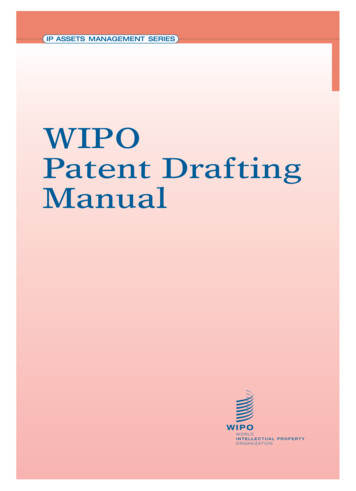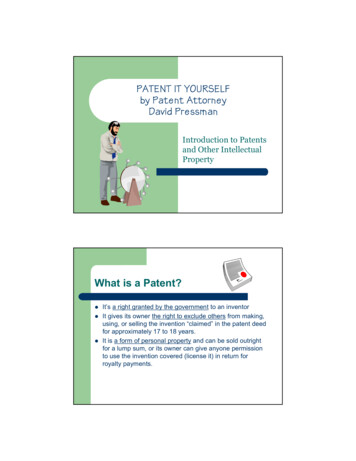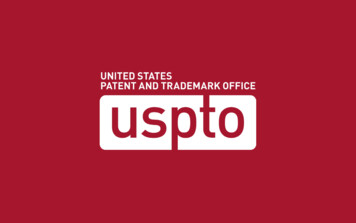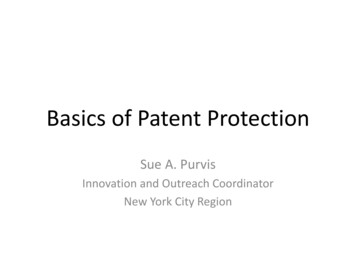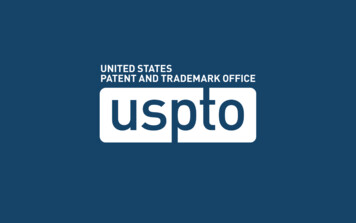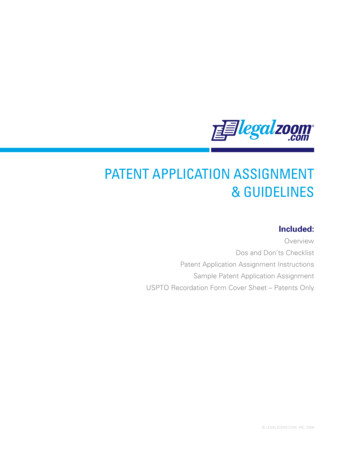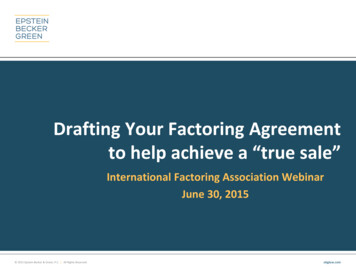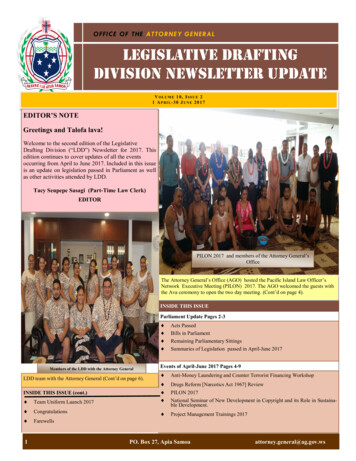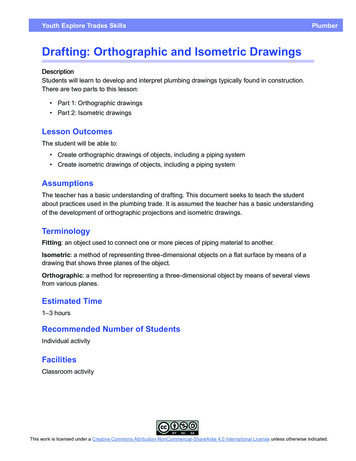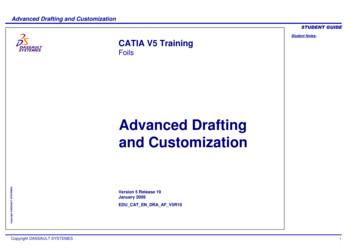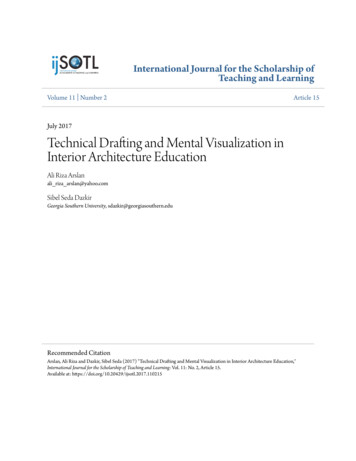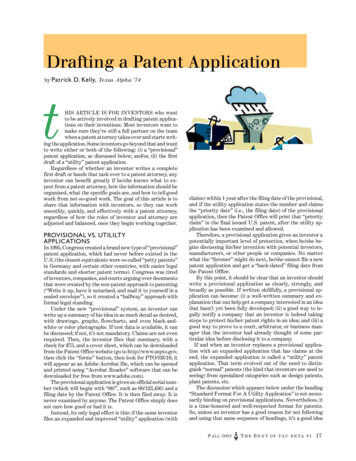
Transcription
Drafting a Patent Applicationby PatricktD. Kelly, Texas Alpha ’74HIS ARTICLE IS FOR INVENTORS who wantto be actively involved in drafting patent applications on their inventions. Most inventors want tomake sure they’re still a full partner on the teamwhen a patent attorney takes over and starts writing the application. Some inventors go beyond that and wantto write either or both of the following: (i) a “provisional”patent application, as discussed below; and/or, (ii) the firstdraft of a “utility” patent application.Regardless of whether an inventor writes a completefirst draft or hands that task over to a patent attorney, anyinventor can benefit greatly if he/she knows what to expect from a patent attorney, how the information should beorganized, what the specific goals are, and how to tell goodwork from not-so-good work. The goal of this article is toshare that information with inventors, so they can worksmoothly, quickly, and effectively with a patent attorney,regardless of how the roles of inventor and attorney areadjusted and balanced, once they begin working together.PROVISIONAL VS. UTILILTYAPPLICATIONSIn 1995, Congress created a brand new type of “provisional”patent application, which had never before existed in theU.S. (the closest equivalents were so-called “petty patents”in Germany and certain other countries, with easier legalstandards and shorter patent terms). Congress was tiredof inventors, companies, and courts arguing over documentsthat were created by the non-patent approach to patenting(“Write it up, have it notarized, and mail it to yourself in asealed envelope”), so it created a “halfway” approach withformal legal standing.Under the new “provisional” system, an inventor canwrite up a summary of his idea in as much detail as desired,with drawings, graphs, flowcharts, and even black-andwhite or color photographs. If test data is available, it canbe discussed; if not, it’s not mandatory. Claims are not evenrequired. Then, the inventor files that summary, with acheck for 75, and a cover sheet, which can be downloadedfrom the Patent Office website (go to http://www.uspto.gov,then click the “forms” button, then look for PTO/SB/16; itwill appear as an Adobe Acrobat file, which can be openedand printed using “Acrobat Reader” software that can bedownloaded for free from www.adobe.com).The provisional application is given an official serial number (which will begin with “60/”, such as 60/123,456) and afiling date by the Patent Office. It is then filed away. It isnever examined by anyone. The Patent Office simply doesnot care how good or bad it is.Instead, its only legal effect is this: if the same inventorfiles an expanded and improved “utility” application (withclaims) within 1 year after the filing date of the provisional,and if the utility application states the number and claimsthe “priority date” (i.e., the filing date) of the provisionalapplication, then the Patent Office will print that “priorityclaim” in the final issued U.S. patent, after the utility application has been examined and allowed.Therefore, a provisional application gives an inventor apotentially important level of protection, when he/she begins discussing his/her invention with potential investors,manufacturers, or other people or companies. No matterwhat the “listener” might do next, he/she cannot file a newpatent application and get a “back-dated” filing date fromthe Patent Office.By this point, it should be clear that an inventor shouldwrite a provisional application as clearly, strongly, andbroadly as possible. If written skillfully, a provisional application can become: (i) a well-written summary and explanation that can help get a company interested in an ideathat hasn’t yet been fully developed; (ii) a good way to legally notify a company that an inventor is indeed takingsteps to protect his/her patent rights in an idea; and (iii) agood way to prove to a court, arbitrator, or business manager that the inventor had already thought of some particular idea before disclosing it to a company.If and when an inventor replaces a provisional application with an expanded application that has claims at theend, the expanded application is called a “utility” patentapplication. That term evolved out of the need to distinguish “normal” patents (the kind that inventors are used toseeing) from specialized categories such as design patents,plant patents, etc.The discussion which appears below under the heading“Standard Format For A Utility Application” is not necessarily binding on provisional applications. Nevertheless, itis a time-honored and well-respected format for patents.So, unless an inventor has a good reason for not followingand using that same sequence of headings, it’s a good ideaF ALL 2002THE BENT OF TAU BETA PI17
to go ahead and use it, in a provisional filing, with one exception: the claims.In a utility application, the claims are what defines theinvention; the claims define the boundaries and limits ofthe exclusive and protectable property that will thereafterbelong to the inventor (or the “assignee” which owns thepatent, such as an inventor’s employer). In provisional applications, claims are not necessary. Some patent attorneysargue that claims should always be included, even in a provisional case, in order to make it clear that the inventorwanted and intended to make such-and-such his property.The author of this article would argue the opposite, andfollows the practice of never putting claims in a provisionalapplication. Why not? Because provisionals should be written and filed quickly, without pains-taking efforts to makesure the prior art has been thoroughly researched andevaluated, the claims have been drafted carefully, etc. Ifthat’s the “modus operandi” of nimble, quick, and agile provisional applications, and if they’re written mainly to getan early filing date, then putting a set of claims into a provisional filing runs a major risk of turning it into a “sittingduck,” where opponents (i.e., their lawyers, who are getting paid by the hour) can argue at great length (and expense)that the claims were invalid, overboard, or whatever. Thesafer approach is to not even have claims that can be attackedand criticized; instead, focus any extra time and effort thatmight be available on making sure the technical summary isas good, reliable, and convincing as possible.Rephrased in the vernacular, don’t try to climb up on ahorse unless you’re ready to ride it. You don’t know whatthat horse is going to do after you’re on it; if it suddenly boltsand takes off, it’s not going to stop just because you ask it to.So, instead of claiming to the world that you’re a skilled riderbefore you’re even up on that horse, approach it with respect,and a bit of caution and humility. If it’s a decent horse at all,it’ll be bigger than you, and stronger than you.In the same way, the tone and content of a provisionalapplication should be, “I think this might be a good idea.I’ve been working in this field for a while, and from whatI’ve seen so far, no one else seems to be doing it.” No onewill try to rip your head off for making a statement likethat. Indeed, if you’re “the little guy,” trying to do something worthwhile and help other people, they’ll probablystart rooting for you.But, if you walk into the office of an experienced manager (or patent attorney) and start saying, “I’ve thought ofa super-colossal idea, and it’s going to make millions, and itbelongs to me,” I can promise you—he’s heard it before,several times, from people who never succeeded at anything (except for wasting other people’s time). His eyes willglaze over, and he’s not going to give you as much respectas you’d like.So, don’t start out by making claims; don’t give the worldthe impression that you think you’ve got the right to decide what belongs to you. Instead, roll up your sleeves, startworking on the problem, and try to convince any onlookersthat you’re more concerned with making a useful contribution than in how much money you’re going to make.If an inventor understands the goals of a provisionalapplication, he/she may be fully capable of drafting, and evenfiling, an adequate provisional application with little or nohelp from a patent attorney. For more information onprovisionals, go to www.uspto.gov/web/offices/pac/provapp.htm, and download the brochure issued by the18 F ALL 2002T H E B E N T O F TA U B E TA P IPatentOffice.Once ana p pl i ca tion getspasttheprovisionalstage, any inventor who triesto draft a “utility”application should always have it reviewed bya patent attorney, before it’s filed. There are hundreds ofcomplexities and hidden traps in the patent laws, especiallywhen it comes to drafting claims. People who have neverstudied law in general, and patent law and claims in particular, aren’t likely to be able to avoid every potential problem without guidance from a skilled professional who knowsthe ropes.In addition, no matter what an inventor’s level of involvement will turn out to be, any inventor should be fully awareof the “prior art” which relates to his/her invention. Withthe explosion of information that is freely available on theInternet, any inventor can do an initial patent search, download the relevant patents in printable form, and study thosepatents, so that when it’s time to talk with the patent attorney, the initial search will already be finished at the lowest possible cost, and the patent attorney can begin building on top of that foundation, rather than starting from“ground zero.”GENERAL COMMENTPatents are written for four entirely different types of readers: (1) scientists, engineers, and other technical specialists; (2) patent examiners, who have degrees in science orengineering but who may not have much expertise in thespecific field you’re working in; (3) judges, who usually haveno training in science or technology except a couple of freshman science courses in college many years ago; and (4)patent attorneys who work for companies that might beinterested in licensing or buying the patent. The best wayto reach all four groups is to be clear, methodical, andstraightforward. Avoid legalistic phrases such as, ‘the hereinbefore mentioned component.’ Plain, clear English is best,and before you describe the invention, give special care tothe “Background” section discussed below.PRIOR ART“Prior art” is a legal term that refers to information that ispublicly available (usually but not always in printed form)on the date you file your application. It includes patents,articles from journals and magazines, chapters from textbooks or encyclopedias, etc. It also includes catalogs, salesbrochures and specifications, ads, technical and field literature such as instruction manuals issued by a manufacturer,etc, so long as the publications are reasonably available tointerested people.Prior art is not limited to publications printed inAmerica, or to publications printed in English. For example,
if a translated abstract or a footnote refers to a foreign article that seems directly relevant, obtain a copy and a translation of that article if possible. Several libraries in America(such as the National Library of Medicine in Bethesda, MD)have extensive collections of foreign journals, so it’s oftenpossible to obtain copies of foreign articles without muchexpense or delay.The relevant prior art includes anything that (1) resembles your invention; (2) bears directly on your invention in any way; (3) describes any major component of yourinvention, even if it does not include other crucial components; or (4) describes how other people tried to solve thesame problem you’re trying to solve. Bring anything whichmight be relevant to the attention of the patent attorney. He(or she) can help you decide what should be brought to theattention of a patent examiner, and what can be omitted.Get three clean copies of the most relevantprior art. One copy is for your own “patentfile.” Keep it separate from your otherfiles, so you can find articles quickly,without having to hunt for them. Typical billing rates for a good patent attorney are about 200/hour, so you don’twant to keep one waiting on the phonefor 15 minutes while you try to find anarticle buried in some pile somewhere.The second copy is for the attorney’sfiles. The third copy will be submittedwith the application.Patent searching is a complex task, butan inventor who makes a diligent effortat it can often come up with one or moreitems that will offer a good start. A greatplace to start is the free (for users) U.S.patent database run by IBM, available atwww.delphion.com. Once you get into themain site, you can use various buttons to doa “Boolean” search, which is a weird wordthat means, in essence, that you can searchby fields (such as by inventor’s names, by assignee names in case a certain patent isowned by a company you’re interested in, and bykey words anywhere in title, abstract, or text). A Booleansearch also lets you use “connecting” words such as ANDor OR to fine-tune the search. For example, if you want tosearch for, say, any patents on heated ice skates, a Booleansearch would let you search for “ice” AND “skat” (whichwould find both “skate” and “skating”) AND (“heat” OR“warm”).Note that the Delphion database also contains information of various foreign patent databases (including European,Japanese, Canadian, and Patent Cooperation Treaty applications), but those must be specified by a special command.Patents can be downloaded in their final form (with coverpages, drawings, etc.) for 4.50 each from www.micropat.com;a user account must be set up, but it’s free.Patents can also be searched using the official PTO database, which is reached through www.uspto.gov. Althoughthat database is a bit clumsier to work with when it comesto patent drawings, the complete texts of U.S. patents canbe downloaded for free from the PTO website; once downloaded, those files can be opened and manipulated using anymodern word processing software. Patents are not copyrighted; they can be reproduced at no charge by anyone.If you obtain a relevant patent, it can help you find moreprior art. For example, the front page lists all items of priorart (patents as well as other publications) that were considered while that patent was being examined. Some databases can also list any subsequent patents that cited a certain patent as prior art.If you have access to a database, it’s a good idea to doyour own search for articles in the scientific literature, fortwo reasons. First, a professional patent searcher mightmiss a relevant item during a manual search. They workwith limited budgets and limited times, so they can neverbe sure they’ve found everything. And second, many professional patent searchers do not search any databases except patents. Many of them don’t use computerized databases, and they don’t consult sources such as Chemical Abstracts. If you’re paying to have a patentability search done,ask the searcher to list the databases that weresearched.If an inventor is seriously interested in doing as much prior artsearching as possible before gettinga patent attorney involved, he/sheshould also find out what kinds of databases or libraries are available inthat field of science or technology.As just one example, anyone whoworks professionally with biochemistry or medicine should know aboutboth (i) the National Library ofMedicine, in Bethesda, Maryland,which is paid for by governmentfunds and which makes its online database available for free, at http://igm.nlm.nih.gov; and, (ii) speciallydeveloped searching software suchas “Grateful Med,” which makes it fareasier and more reliable for even anovice to get good and reliable results, using a well-developed andhighly sophisticated set of “MESH”(medical subject heading) terms that areassigned to articles by a corps of technicianspecialists at the NLM. That is just one example of an extraordinarily useful cost-saving resource in one particularfield of research; various others are available, and the experts in a certain field (including government employees,and librarians who work at specialized libraries in universities) are the best way to identify and locate similar resources in any other field of research. Most large universities have a chemistry library, a biology library, and an engineering library, all separate, and all with at least one reference specialist who works at that particular library. Such librarians are excellent sources of guidance on where to lookfor information, and they often will do a for-pay literaturesearch, for a local inventor, at rates which are usually significantly less than the costs of a typical patent search.STANDARD FORMAT FOR A “UTILITY”APPLICATIONThe headings listed below are standard. They can be altered if necessary for a clearer presentation, and subheadings may be added at will. In the early stages, it’s convenient to start each major section on a new sheet of paper incase you need to add more information to any section.F ALL 2002THE BENT OF TAU BETA PI19
The title should be short (fewer than about eight words).It’s a finding aid only and does not restrict the coverage ofthe patent.GOVERNMENT SUPPORTOmit this heading unless government funding was used.Otherwise, indicate which agency provided the funds. Thegrant number is optional.FIELD OF THE INVENTIONUnless the general field is immediately clear from the title,list a broad field of technology (such as chemistry, pharmacology, automotive, machinery, computers, electronics, surgery, dentistry, agriculture, pesticides, etc.) Then cite amore specific field or goal, such as “More specifically, thisinvention relates to drugs for treating XYZ syndrome,” or“This invention relates to an improved widget for shiningshoes.” This section is not crucial; it simply helps a docketclerk in the Patent Office figure out which examining group(“art unit”) should receive and examine the application.BACKGROUND OF THE INVENTIONThis section should contain three types of information:1. Describe the context of the invention. Although manypatents provide very little background information, this isa good chance to create a good first impression. Draft a shortessay describing that particular field of science, two to fivepages long (double-spaced), so that an intelligent personwho has never studied that area of technology will be thinking, “That’s interesting; I never knew how that worked,”when he or she finishes that section. Explain each important term at any length necessary to convey a clear understanding of that term. Point out distinctions, subtleties, andsubstitute terms, especially if a certain word isn’t used thesame way by everyone. Avoid dictionary definitions; thosewere written by grammarians who had to be brief, ratherthan scientists or engineers who appreciate the complexities of science and technology. Explain key terms not justas definitions, but in terms of how each component relatesto other components. And, in case you leave anything out,give citations to a couple of standard textbooks or reviewarticles used by scientists or engineers who work in thatspecialty.This set of paragraphs can also refer to broad problems,such as industrial, technical, or social problems the invention can help solve.2. After the introductory essay, focus on specific itemsof prior art. Full citations can be inserted into the text, or ifnumerous references are cited, abbreviated citations (e.g.,“Smith 1980”) can be used if you provide a list of completecitations at the end of the text. Titles of articles are optional.For each piece of prior art, provide three different piecesof information. The easiest and clearest way is to draft threeparagraphs. First, summarize the item of prior art. Howdoes it work, what does it do, and how is it used? Point outdirectly relevant passages by page number (or by columnand line number in patents).Second, describe the limitations of that item of prior art,in factual language. Don’t say it’s obsolete, clumsy, or absurd; instead, point out its limitations in clear, factual termsas a preface to describing the superiority of your invention. Comparative terms such as ‘less expensive,’ ‘more convenient,’ and ‘relatively high’ are fine, if it’s clear what20 F ALL 2002T H E B E N T O F TA U B E TA P Ithey’re being compared against. If the prior art could notaccomplish a desirable goal, describe it. If the prior art hasshortcomings (for example, prior machines had numerousmoving parts, which made them expensive to manufacture,difficult to operate, and prone to breaking or jamming),describe those shortcomings. This sets the stage for theusefulness of the invention.And third, point out why your invention is different andbetter.These three paragraphs might be combined or reorganized in the final application, but setting forth each paragraph separately will help the inventor organize the necessary information and convey it clearly to a patent attorney.This advice, about creating 3 different paragraphs oneach item of prior art, is a very good and very cost-savingpiece of advice. The problem is, most inventors think theycan do it, without actually doing it. They can—and almostalways do—easily tell the patent attorney everything theyknow about each item of prior art. And that, to the inventor, works just fine. The problem is, the patent attorneyprobably won’t actually start drafting the patent application until several days or weeks later, and by then, severalpieces of prior art are all schlumped together in a pile orfile, and now the patent attorney has to sort through them,try to remember what the inventor said about each one,and either dictate or write a narrative analysis that sortseverything out.So, here is probably the single best piece of advice inthis entire article for inventors who want to save time,money, and aggravation when working with a patent attorney. For each important piece of prior art, write down, using no more than 1 or 2 sheets of paper, the three differentparagraphs listed above (the brief summary; the limitationsof that piece of prior art; and, why the new invention isbetter). Then, staple or paperclip that page, with your 3paragraphs, onto that piece of prior art. Then, give it to thepatent attorney. If you’ll do that, and actually do it insteadof just thinking about what you’d say if you did it, you’ll beamazed at what a good patent attorney can do from thatstarting point and how quickly he or she can do it. It willhelp the patent attorney draft an application better andfaster, and then, a year or two later after a Patent OfficeAction arrives with an “obviousness” rejection, it will helpthe patent attorney remember and figure out what happened, and why, a whole lot faster, which will save you evenmore money. So don’t just think about it—do it. If you wantto save money, write up all 3 paragraphs for each of theclosest items of prior art, and give those analyses to thepatent attorney.3. Finally, list a set of goals and objectives for your invention. For example, “One object of this invention is tocreate a simple, inexpensive, and durable hyper widget withfewer moving parts, and which can bounce higher than anyprevious widget or hyper widget. Another object is to create a hyper widget which can generate a more concentratedvacuum in a smaller space. Another object is to create ahyper widget which can be manufactured without requiring any radioactive elements or toxic chemicals and whichgenerates less waste during the manufacturing process.”SUMMARY OF THE INVENTIONThis should be a brief (one page or less) overview for someone who doesn’t know anything about the invention. Thissection (often repeated verbatim as the Abstract) will be
published by a number of data servicesafter the patent issues, and it will beread by peoplewho will decidewhether to ordera copy of the entire patent. Afterdescribing theinvention itself,add one or twosente ncesindicating how itis used and/orwhy it is useful.A lot ofpeople will readthe paragraphabove and nodtheir head and say,“Yeah, yeah, I cando that,” when theyreally can’t do it capably, because they’ve never practiced it. It is a genuinechallenge to try to summarize a complex idea in a singlepage of writing, and any inventor is urged to take that challenge and actually do it. One of my standard practices whenI begin working with an inventor is to tell him or her, “Giveme a three-to five-minute overview with a summary of thewhole invention. Don’t start me out by walking me down astreet and pointing out one building after another. Instead,show me a map of the place. Tell me where we’re startingout, and where we’re going to. And then, once we startwalking down those streets and seeing those buildings, I’llhave a better sense of how everything fits together, andwhere it’s heading.”To me, that’s an entirely reasonable, obvious, and logical request. And yet, at least half of all inventors will respond to that request by waving their hand in the directionof a map, and then ignoring it, and start me walking downsome street I haven’t seen before, while I have no ideawhere that street is heading or why I’m going in that direction. I’ll usually listen patiently for about 15 minutes,then I’ll gently but firmly interrupt the person and say,“Remember how I asked for a 3-minute summary, about 15minutes ago? Well, I never got it. This tour you’re givingme is very interesting, but I don’t have any idea where it’sleading, or how these pieces all fit together. So, let’s startover. Can you please give me about a three-minute summary of what this invention is about, what it does, and whyit’s useful?”BRIEF DESCRIPTION OF THE DRAWINGSTypical figure legends might read:Figure 1 is a plan view showing the hyper widget of thisinvention.Figure 2 is a side elevational cutaway view along line2-2 on Figure 1.Figure 3 is a circuit diagram of a control unit for thehyper widget of this invention.Figure 4 is an exploded view showing the componentsof this invention.Figure 5 is a chromatograph showing the purification ofthe ABC substance.Figure 6 is a graph showing a plateau in blood concentrations over a prolonged period after injection of the drug.“Drawings” includes line drawings, graphs, flow-charts,etc. It does not include tables. Many chemical patents donot contain drawings; however, a flow chart describing asequence of steps, a plasmid map, a DNA or amino acidsequence, or any other information, can be provided as adrawing if it will help explain the invention. Chemical structures or formulas can be inserted directly into the text,unless they are very lengthy. Small strip charts and othermachine-generated data can be provided if they are properly inked to convert them into clearly reproducibleblack-and-white drawings.The PTO is very reluctant to print photographs in patents because of the printing expense. However, any goodphotographs should be shown to the attorney, and they canbe submitted to an examiner in a statement that will not beprinted as part of the patent.Carefully consider the best way to show your inventionvisually. Many patent attorneys and examiners look at thedrawings before the text, so drawings can create the firstimpression. For that reason, they’re worth extra effort.Study the drawings of several patents in the same field asyour invention. That will give you a sense of how patentdrawings are arranged and what their goal is.When you’re ready, draw up your own rough drafts.Even if they aren’t high quality, they’ll help the draftsman.Your only goals are to make them large and clear. Try tomake each drawing (even drawings of sub-components) fillup at least two thirds of a sheet of paper. Paper is cheap,and there are few things more annoying to patent attorneys than staring at a tiny little squiggle while listening toan inventor point out a dozen parts that are invisible to anyone but him. Computer-generated drawings are often helpful, and they can sometimes be used as the formal drawings.Drawings in patents normally use “call-out numbers”which are explained in the text. Inventors should avoidthose; don’t even try to assign any numbers. Instead, givethe patent attorney two copies of your hand-drawn versions. On one copy (the “plain vanilla” copy), don’t put anywords or numbers at all; just draw the device, graph, orwhatever, and leave the drawing as open and clean as possible so the patent attorney will be able to use it in any wayhe chooses. On the second copy, add labels (words orphrases) to identify each component, or to point out specific things that deserve extra attention in the drawing. Putany labels out around the edges of the paper, and use arrows to point out each labeled piece. Use that drawing toassign any names you want to assign to any specific components that need to be named. The attorney will assigncall-out numbers later after he gets an idea of how the finaldrawings should appear.Drawings of prior art are rarely printed in patents. However, such drawings can help a patent attorney figure outhow your invention works, so if there are any good priorart drawings, make copies and include them with your firstdraft. Clearly label them as prior art (for example, “This isthe device described in patent 4,567,890 by Smith”).Even though drawings are important, in some situationsit may be appropriate to file a patent application with “informal” drawings. These can be drawn by an inventor orpatent attorney using simple tools (straight-edges, templates, etc.), or they can be drawn by computer graphics. IfF ALL 2002THE BENT OF TAU BETA PI21
adequate versions can be generated, the expense of havingformal drawings done by a professional draftsman can bedelayed until after the application has been examined andallowed. If a Notice of Allowance is received, formal drawings can be created, and if the application isn’t allowed, thatexpense can be avoided entirely. In addition, if an inventoris in a big hurry to get an application filed, informal drawings can be used to eliminat
standards and shorter patent terms). Congress was tired of inventors, companies, and courts arguing over documents that were created by the non-patent approach to patenting (“Write it up, have it notarized, and mail it to yourself in a sealed envelope”), so it
